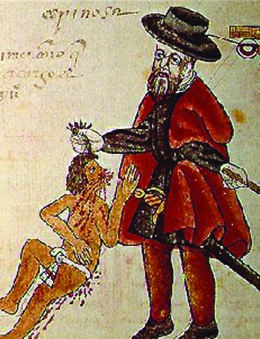| << Chapter < Page | Chapter >> Page > |

Las Casas’s writing about the Spaniards’ horrific treatment of Indians helped inspire the so-called Black Legend , the idea that the Spanish were bloodthirsty conquerors with no regard for human life. Perhaps not surprisingly, those who held this view of the Spanish were Spain’s imperial rivals. English writers and others seized on the idea of Spain’s ruthlessness to support their own colonization projects. By demonizing the Spanish, they justified their own efforts as more humane. All European colonizers, however, shared a disregard for Indians.
Bartolomé de Las Casas’s A Short Account of the Destruction of the Indies , written in 1542 and published ten years later, detailed for Prince Philip II of Spain how Spanish colonists had been mistreating natives.
Into and among these gentle sheep, endowed by their Maker and Creator with all the qualities aforesaid, did creep the Spaniards, who no sooner had knowledge of these people than they became like fierce wolves and tigers and lions who have gone many days without food or nourishment. And no other thing have they done for forty years until this day, and still today see fit to do, but dismember, slay, perturb, afflict, torment, and destroy the Indians by all manner of cruelty—new and divers and most singular manners such as never before seen or read or heard of—some few of which shall be recounted below, and they do this to such a degree that on the Island of Hispaniola, of the above three millions souls that we once saw, today there be no more than two hundred of those native people remaining. . . .
Two principal and general customs have been employed by those, calling themselves Christians, who have passed this way, in extirpating and striking from the face of the earth those suffering nations. The first being unjust, cruel, bloody, and tyrannical warfare. The other—after having slain all those who might yearn toward or suspire after or think of freedom, or consider escaping from the torments that they are made to suffer, by which I mean all the native-born lords and adult males, for it is the Spaniards’ custom in their wars to allow only young boys and females to live—being to oppress them with the hardest, harshest, and most heinous bondage to which men or beasts might ever be bound into.
How might these writings have been used to promote the “black legend” against Spain as well as subsequent English exploration and colonization?
Indians were not the only source of cheap labor in the Americas; by the middle of the sixteenth century, Africans formed an important element of the labor landscape, producing the cash crops of sugar and tobacco for European markets. Europeans viewed Africans as non-Christians, which they used as a justification for enslavement. Denied control over their lives, slaves endured horrendous conditions. At every opportunity, they resisted enslavement, and their resistance was met with violence. Indeed, physical, mental, and sexual violence formed a key strategy among European slaveholders in their effort to assert mastery and impose their will. The Portuguese led the way in the evolving transport of slaves across the Atlantic; slave “factories” on the west coast of Africa, like Elmina Castle in Ghana, served as holding pens for slaves brought from Africa’s interior. In time, other European imperial powers would follow in the footsteps of the Portuguese by constructing similar outposts on the coast of West Africa.

Notification Switch
Would you like to follow the 'U.s. history' conversation and receive update notifications?